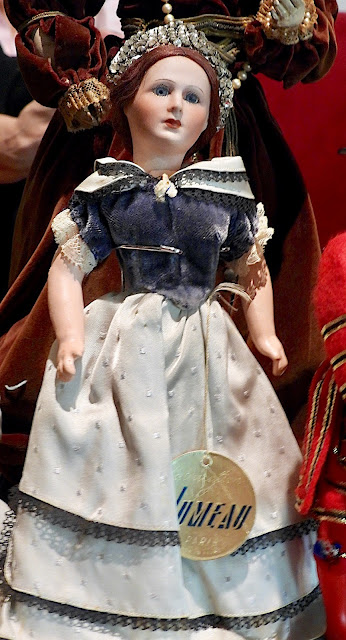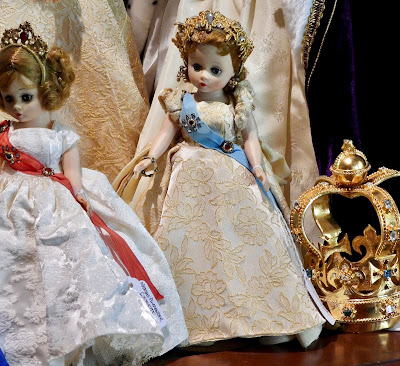Loading
In memory of Queen Elizabeth II, this month's theme was queens.
Member Sharon Weintraub displayed two doll heads, one of fine bisque and the other of carved wood. Both heads had the hair tucked into a snood, with a scarf draped over on side of the head and a plume on the other. She explained that this style of head is known to collectors as Empress Eugenie. Empress Eugenie was the consort of Napoleon III, who reigned as the emperor of France from 1852 until 1870. Sharon stated that there is no evidence the head is actually a portrait of the empress, but that this is just a name given this type of head by early doll collectors. The wooden head was found in an antiques market in Barcelona, Spain, and is expertly carved.
She also shared this French fashion doll by Francois Gaultier on a jointed wooden body. The doll is dressed in an old beautifully tailored and hand sewn outfit, including layers of undergarments. Pinned to the back of her slip is a yellowed note declaring in French "Margueritte of France, Sister of Francis the 1st." This would indicate that the doll represents Margaret of Valois, who became Queen of Navarre upon her marriage to Henry III of Navarre in 1572 and then rose to Queen of France at her husband's 1589 accession to the latter throne as Henry IV. Sharon pointed out that the doll should be more properly dressed in Elizabethan garb rather than a romanticized outfit of the Middle Ages.
Sharon displayed this 9.5-inch tall bisque-headed doll representing Queen Victoria. The doll is part of the "Femmes Célèbres" ("Great Ladies") series produced by Société Française de Bébé and Jouets (S.F.B.J.) in the 1940s. Her round paper tag reads "Fabrication Jumeau Paris Made in France" on one side and written in ink on back of label is "Victoria I Reine d Angleterre Cirque 1860."
Member Sylvia McDonald brought this 1992 Madame Alexander doll dressed in a coronation outfit, complete with crown and velvet robe
On one side of the doll are dolls in elaborate uniforms by English doll artist Peggy Nesbitt. The older man represents a yeoman warder, who guards the Tower of London and the crown jewels displayed therein. The other man represents a palace guard wearing his signature "bearskin" helmet. The actual helmets are made of Canadian bear skins and were originally intended to make soldiers look taller and more intimidating in battle.
A doll peddler, also by Nesbitt, admires the pomp and circumstance.
Member Myrna Loesch brought this collection of Madame Alexander Cissy and Cissette dolls in coronation gowns. The lovely lady in the purple robe dates from 1955. Myrna pointed out the doll's "ruby" and "diamond" bracelets, explaining that the jeweled cuffs worn by Queen Elizabeth during her coronation were a symbol of her sovereignty. The other Cissy dates from 1957 and wears a replacement crown made by Myrna. The purple robe, large golden crown, and specter belong to Member Jan Irsfeld and were made by Alexander to commemorate the 20th anniversary of Elizabeth's coronation.
The Cissette in the golden floral dress is from 1958. The doll with the red sash dates from 1972-73.
Member Elaine Jackson shared this book, first published in 1950, written by Marion Crawford, who was the governess to Princess Elizabeth and her sister, Margaret.
Member Elaine McNally displayed some of her latest wood and cloth creations.
Guest Pam Hardy brought this artist doll to share. She purchased it on a tour of Germany. The doll has a handwritten paper tag that says "matrosen mädchen," or "sailor girl."


























